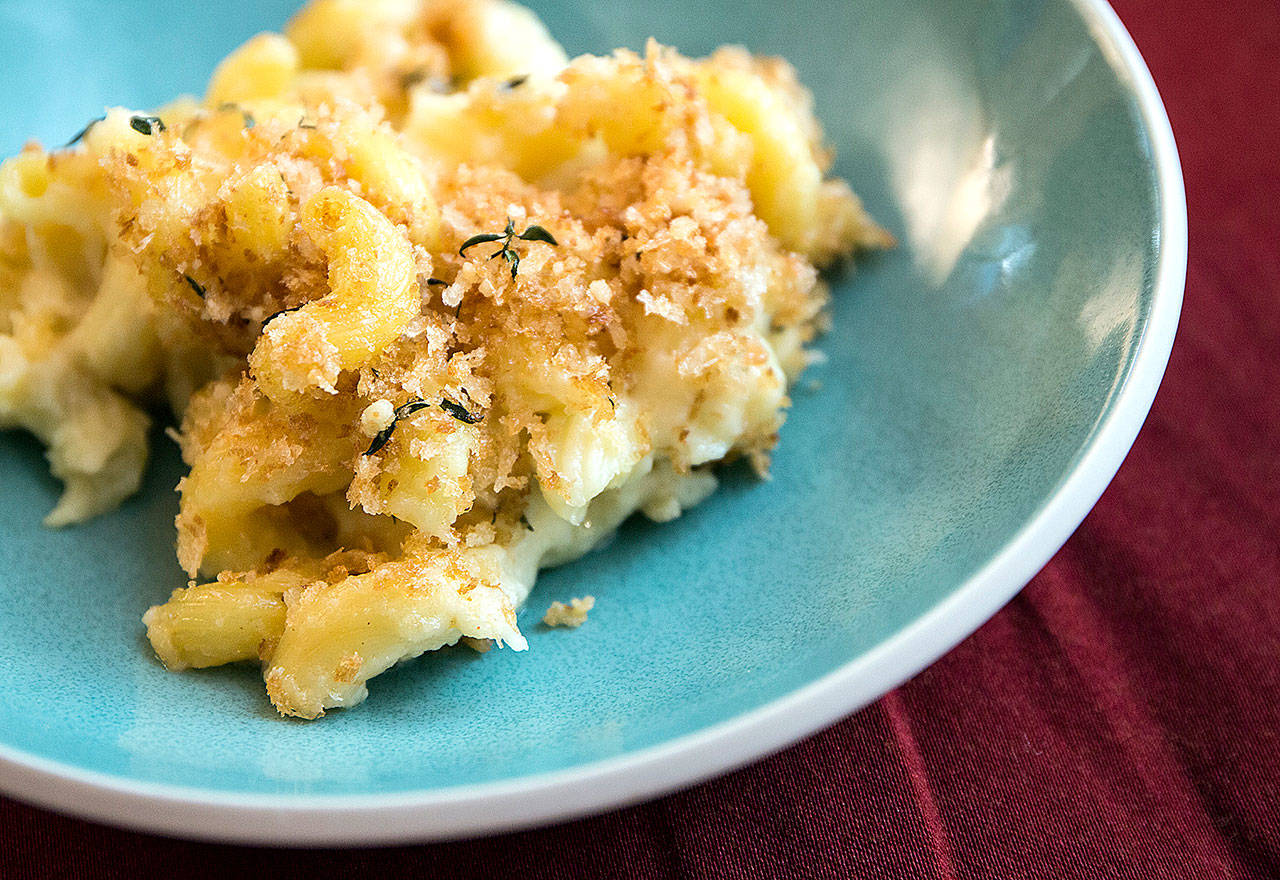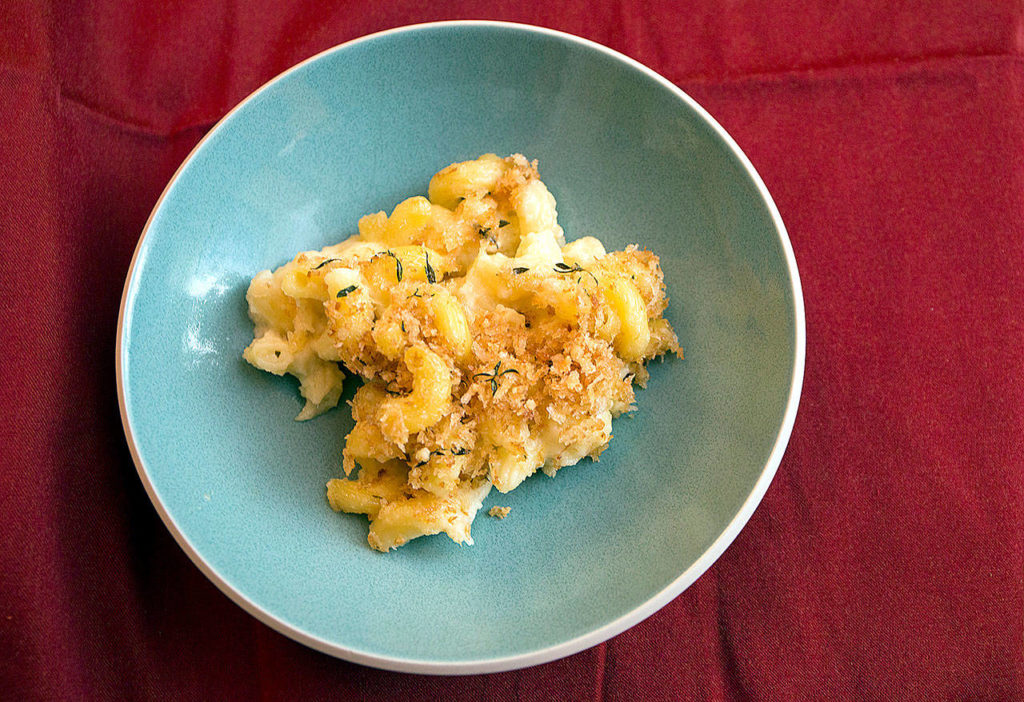By Susan Selasky / Detroit Free Press
Homemade macaroni and cheese is one of the ultimate comfort foods.
But what was once considered more a dish for kids has evolved and now occupies a spot on even upscale restaurant menus. Some chefs make it plain, and some dress it up with mix-ins like bacon, seafood or veggies.
Although many of us grew up with quick-fix mac and cheese from a blue box, the homemade variety is by far superior. It’s also simple to put together: Cook some pasta, make a sauce, add a crumb topping and bake. With macaroni and cheese it’s all about the right stuff, including the right blend of cheeses. (Yes, you should use more than one.) To get just the right level of creaminess, start out with a bechamel sauce.
As we head into the holidays, time is an item on plenty of wish lists. If you’re looking to put together a hearty and satisfying dish in just a little time, think mac and cheese.
There are plenty of recipes out there, and I’ve tried lots of them over the years. However, today’s is a keeper. My co-workers loved this version, adapted from Bon Appetit.
Here are some tips for success.
What kind of pasta should you use? Although elbow macaroni is fine, cavatappi is the go-to. “Cavatappi” is the Italian word for “corkscrew.” It has ridges that capture and hold onto that creamy bechamel so you get a good amount of sauce in every bite.
How should you cook the pasta and for how long? It’s best to use plenty of salted water. The water should taste salty. Most packages recommend six quarts of water. The pasta should be swimming in it. As a general rule, when pasta is going to be cooked again (baked in this case), you should undercook it slightly. Figure about 2 minutes less than the suggested time on the package.
What’s a bechamel sauce? Bechamel is a rich white sauce that starts out with a roux (a mix of butter and flour). The name sounds fancy, but it’s not hard to make. Many lasagna recipes have a bechamel sauce. Once you cook the butter and flour, you add warm milk. (This is where you can add in any spices if you like.) The mixture will thicken some so it coats the back of a spoon. When you add the cheese, take the saucepan off the heat. This allows the cheese to melt gradually.
What’s the best cheese? Go for a blend of creamy, tangy and sharp. But go with your budget. Fontina provides a creamy texture and is a good melting cheese. Gruyere, another creamy cheese, has mild nutty nuance and slight tangy bite. Sharp cheddar is just that, sharp with a tangy bite. Shred the cheese using a box grater. If you use chunks, the cheese likely will melt unevenly and you might end up with clumps. You can buy pre-shredded cheese, but some pre-shredded cheeses use potato starch as an ingredient to prevent caking.
How long do you bake it? Once the sauce and noodles are cooked, you can serve it as is. But why stop there? Add a seasoned bread crumb topping and bake a bit longer to crisp the top layer.
Best macaroni and cheese
4 tablespoons unsalted butter, divided
¾ cup panko (Japanese breadcrumbs)
¼ cup Parmesan, finely grated
2 teaspoons fresh thyme leaves
1 teaspoon kosher salt, divided, plus more
8 ounces cavatappi or other short curly pasta
2½ cups 2 percent or whole milk
½ small onion, grated
1 garlic clove, finely grated
2 tablespoons all-purpose flour
1 cup shredded Fontina cheese
1 cup shredded Gruyere
1 cup shredded white cheddar, grated
½ teaspoon English mustard powder
Pinch of cayenne pepper, optional
Preheat oven to 350 degrees. Melt 2 tablespoons butter in a medium skillet over medium heat. Add panko and cook, stirring, until crumbs are golden brown, 6-8 minutes. (Make sure to get them toasty brown; they won’t darken much during baking.) Transfer to a small bowl and toss with Parmesan, thyme leaves and ¼ teaspoon salt.
Meanwhile, cook pasta in a large pot of boiling salted water, stirring occasionally, until al dente. (The noodles will continue to cook in the cheese sauce, so take them out a minute or two before you think they’re actually done.) Drain pasta; let cool while you make the sauce.
Heat milk just to a simmer in a saucepan or microwave; keep warm.
In a medium saucepan, melt the remaining 2 tablespoons of butter over medium-high. Add onion and garlic and cook, stirring, until onions are fragrant and beginning to soften, about 2 minutes. Sprinkle flour over and cook, stirring constantly, until mixture starts to stick to bottom of saucepan, about 1 minute. Add warm milk in a few additions, whisking to combine after each addition.
Bring bechamel sauce to a boil, then reduce heat and simmer, stirring, until sauce is thickened and doesn’t feel grainy when a little bit is rubbed between your fingers, 6-8 minutes. (Cooking the flour thoroughly at this stage ensures a creamy sauce and no flour taste.) Remove from heat and stir in the cheeses, mustard powder, cayenne and ¾ teaspoons salt or to taste. Stir until the cheeses are melted and sauce is smooth. Remove from heat and mix in pasta; transfer to a 2-quart buttered baking dish.
Bake 10 minutes. Top with Parmesan breadcrumbs and bake until sauce is bubbling around the edges, 8-10 minutes longer. Let cool in pan 15 minutes before serving.
Makes 4 (generous) servings.
— Adapted from www.bonappetit.com.
Talk to us
> Give us your news tips.
> Send us a letter to the editor.
> More Herald contact information.


























